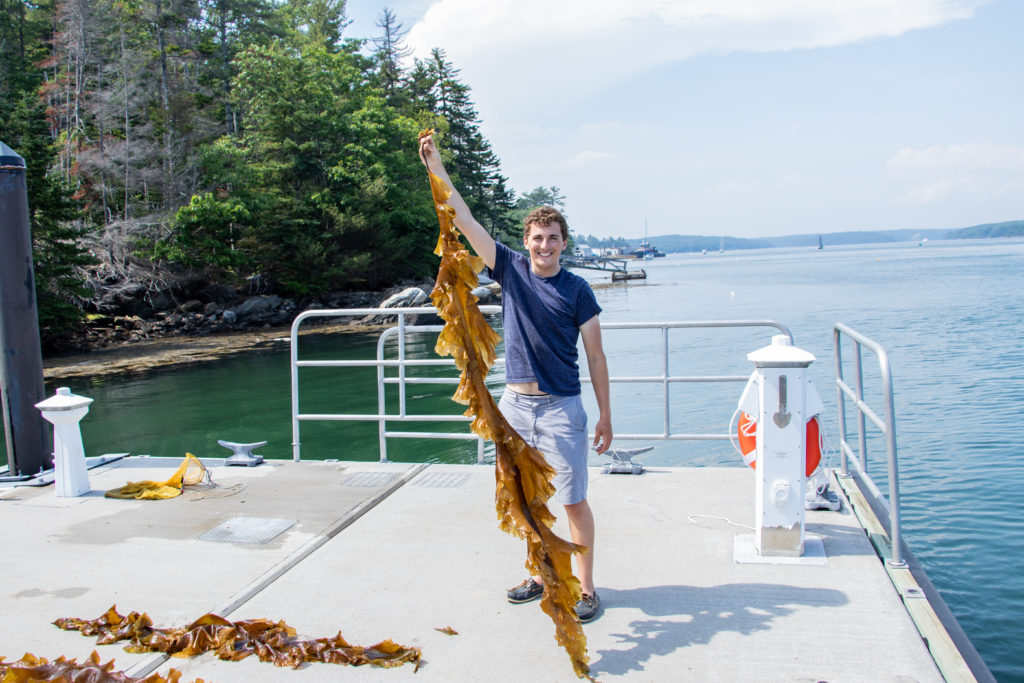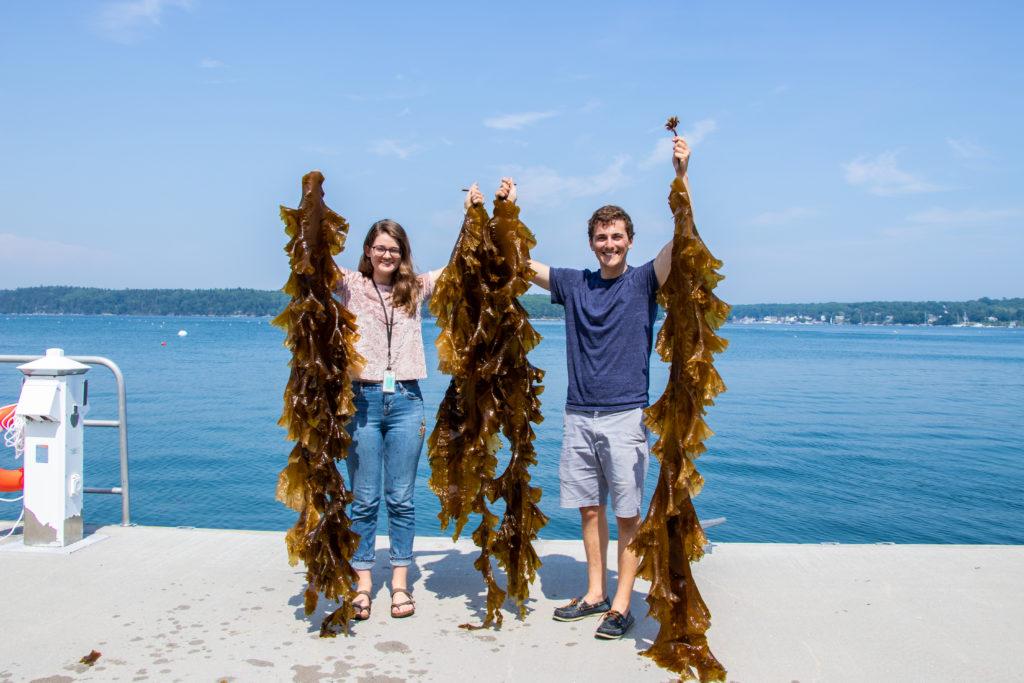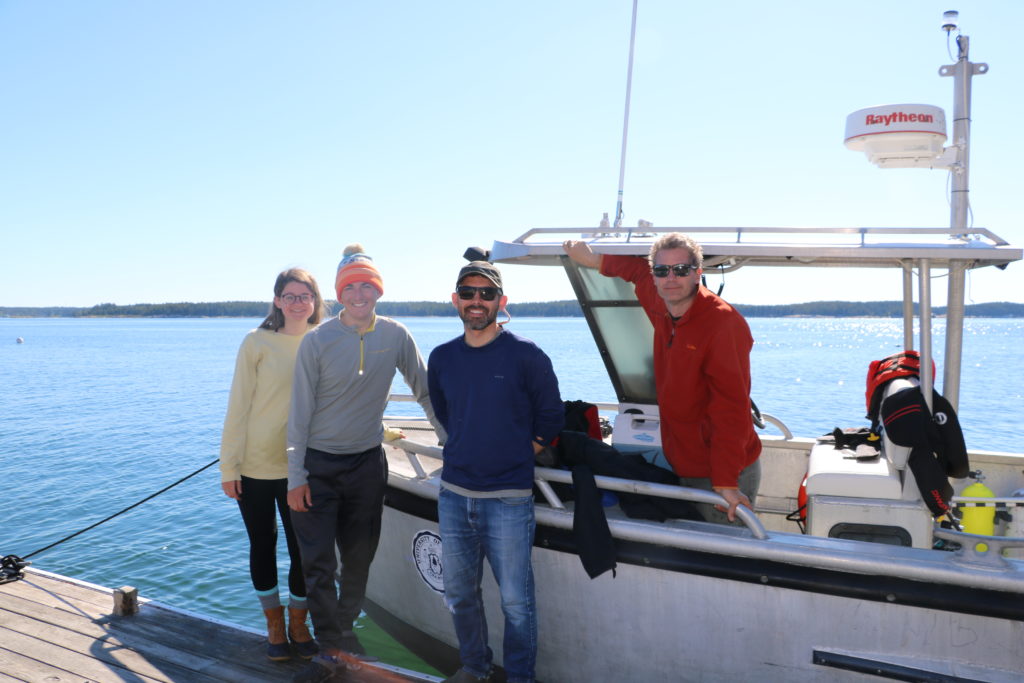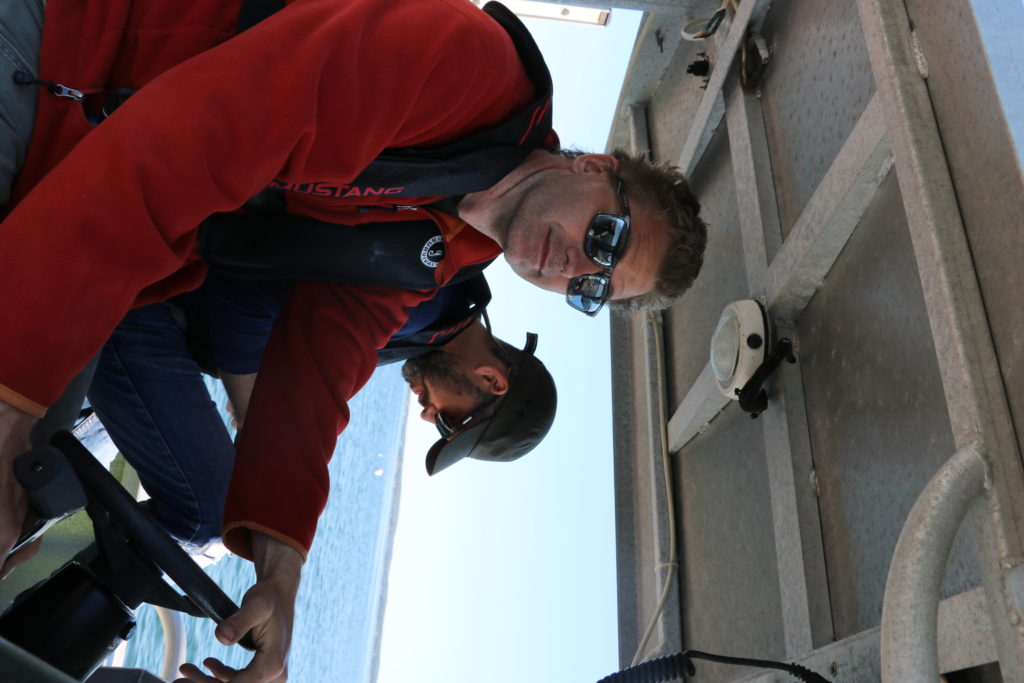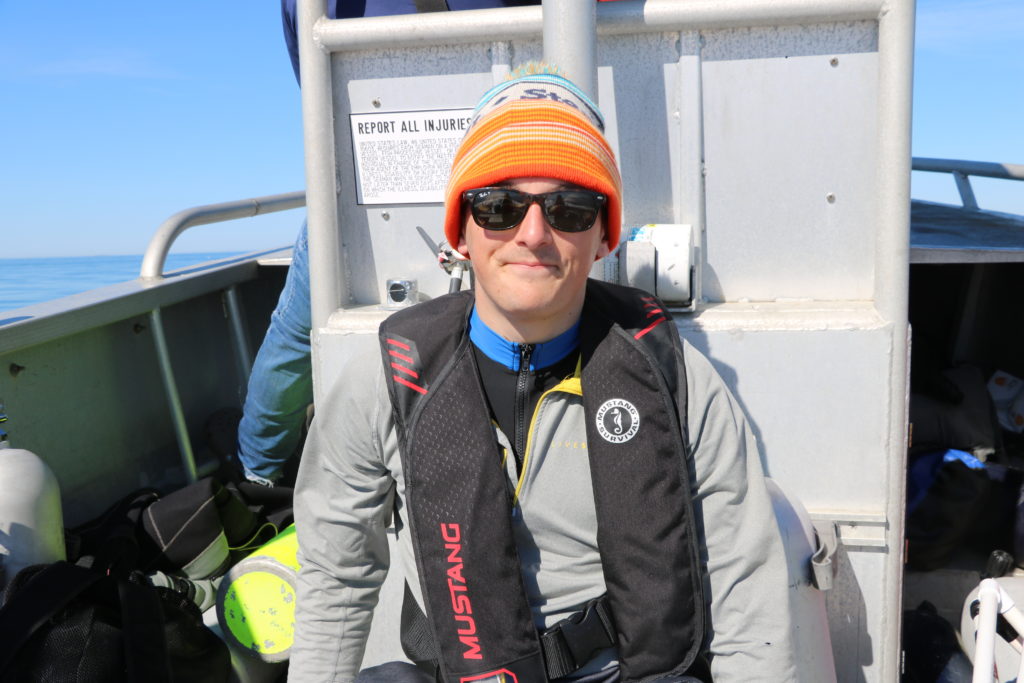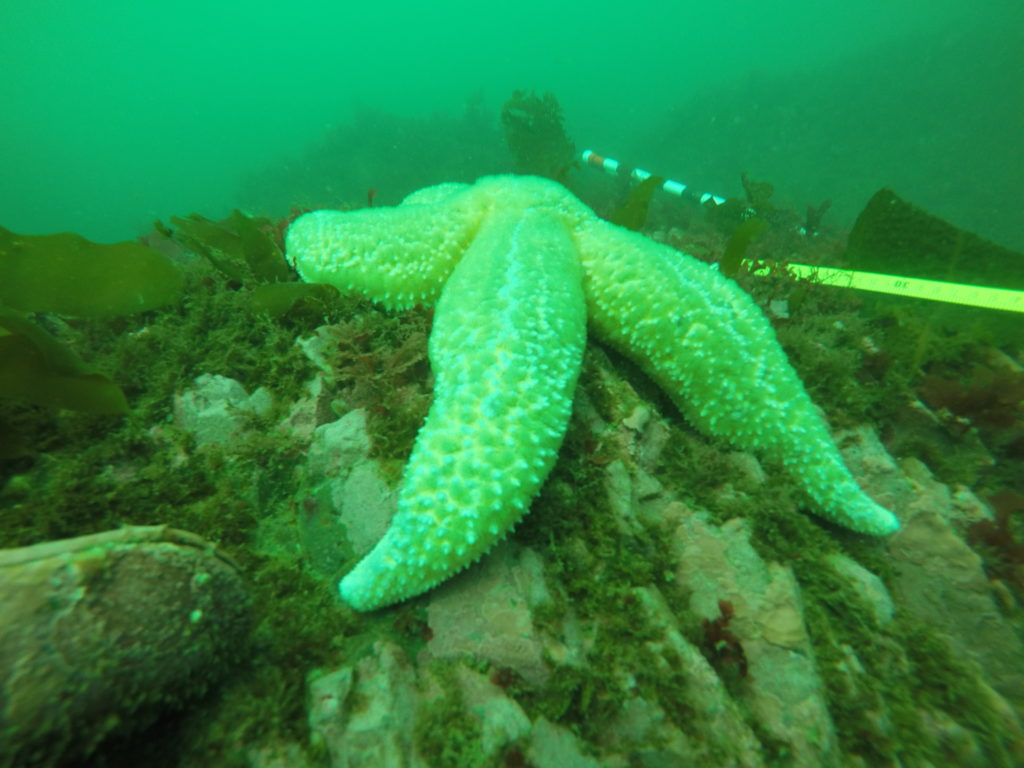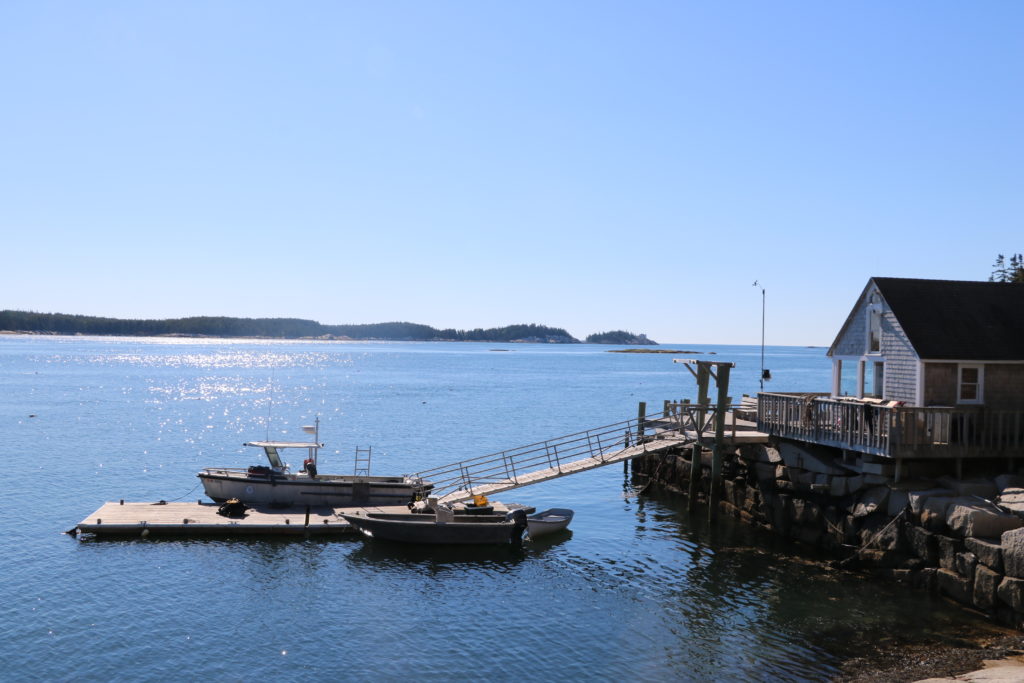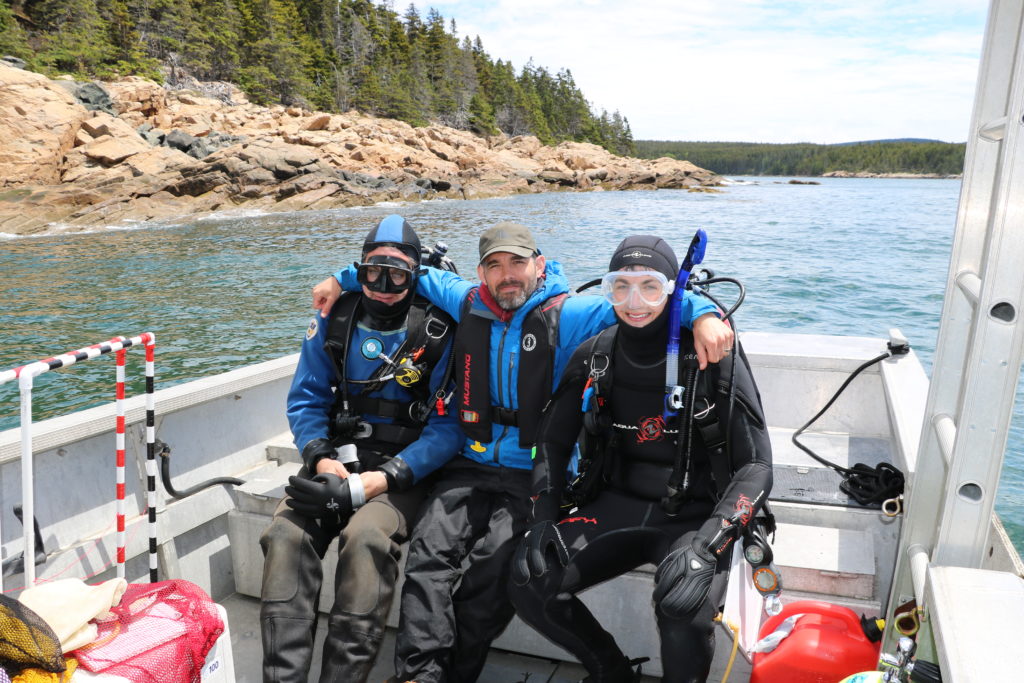This week was dive intensive. Early in the week, Monday and Tuesday, I finished digitizing the old kelp data thus making it possible for Courtney to make maps of the kelp using geographic information systems (GIS) using ArcMap to visualize the data. Using these maps, we can see that kelp is moving further north to colder waters, along with a change in species composition. Cold water species such as Alaria esculenta are virtually non-existent in the warmer southern waters which are predominantly inhabited by other species like Saccharina latissima and Laminaria digitata.
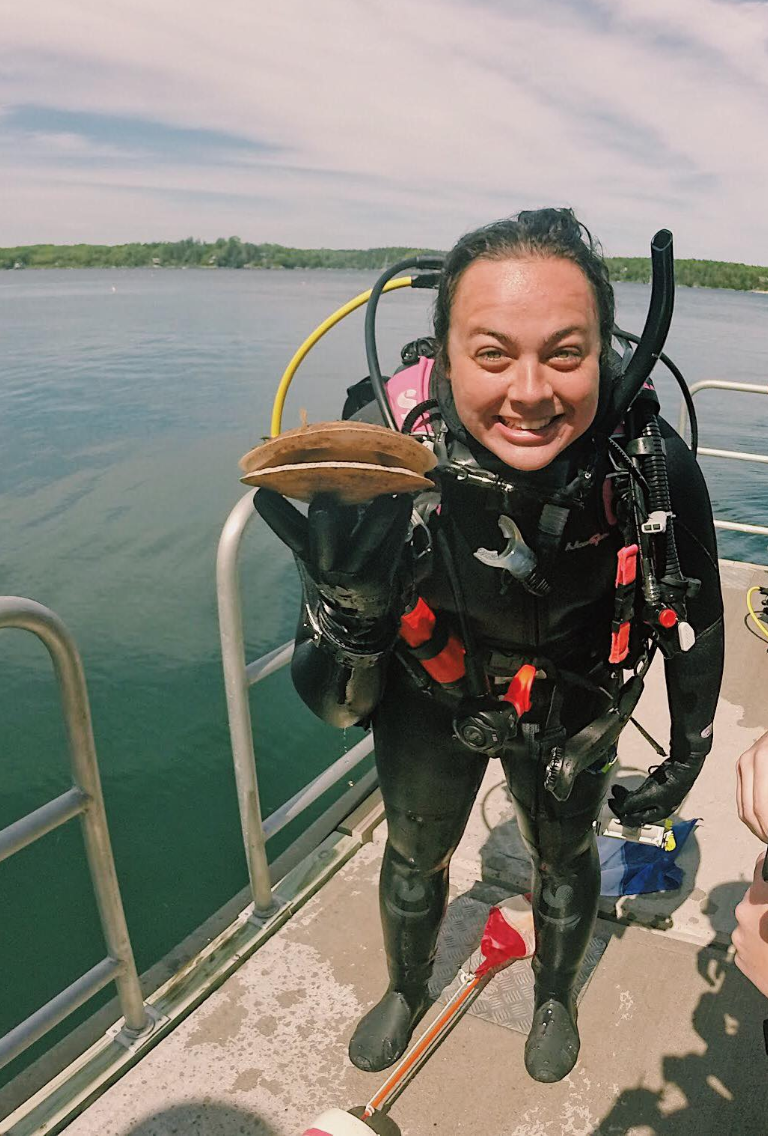
Hattie, a dive master for the AAUS class, having some fun with a giant scallop!
On Wednesday I had my third AAUS class. This class is always a highlight of the week due to the close community we have formed in such a short period. With only six people in the class, three instructors and three students, it is a more intimate and fun atmosphere with jokes and laughter flowing each day. Chris keeps the class upbeat but keeps us focused on learning and our diving tasks for the day. This Wednesday we headed to my neck of the woods, Bigelow Labs, to complete a dock dive from their property in the Damariscotta River. The purpose of these dives was to plan and execute a multi-level dive starting at 45 feet and progressing upwards. Bigelow is uniquely suited for a dive like this, right off their dock is 20-30 feet of water and a short 20-foot swim will drop you into 60 feet. We completed two multi-level dives while getting to experience a different environment from our previous dive site Sand Cove. We saw massive kelp, five to six feet long, and giant scallops almost the size of dinner plates. Lobsters, Jonah crabs, and Green Crabs inhabit every crack and crevice.
Thursday was finally my first true scientific dive a Bigelow! We woke up early and prepared the gear and loaded the boat to be on the water by 8:00 a.m. We had four dives planned for the day – two dives at Damariscove, one at 10 meters the other at 5 meters, while two more dives at Pemaquid at the same depth profiles.
We will be sampling these two sites plus 18 others this summer. Each site has been sampled back in 2004 with little knowledge about the changes over the last 14 years. The return of these kelp beds to Maine have been understudied in the past years. The aquatic ecosystem in Maine long ago was a more diverse system with many trophic levels and a complex food web. Cod was a top predator eating smaller fish and keeping the sea urchin population at bay. However, in the 1950s we started fishing cod and nearly fished cod to extinction in the 1990s. Without these top predators left in the waters of Maine, sea urchin population spiked. Sea urchins are incredible but destructive organisms. Their appetite is unquenchable; urchins can eat 2-4 percent of their body weight each day! Sea urchins also have a preferred food of choice: kelp. Thus, with the fall of cod and the spike in urchin populations, kelp was quickly being eaten and obliterated by the urchins. In 15 years kelp beds, like cod, were gone leaving empty sand and rock patches with only urchins, known as “urchin barrens.” However, Mainers are resourceful and like to make money. Urchins and their gonads are a valuable delicacy in Asia and quickly people started to dive and snorkel for these small spiny creatures. The business was so lucrative and easy that in less than ten years Mainers had fished almost all the sea urchins from the Gulf of Maine. In those ten years, it is estimated that 250,000,000 urchins were taken from Maine’s waters! With the decimation of the urchins, kelps soon started to return to the Gulf of Maine. And here we are today, kelps are returning, yet no one really knows how much has returned, which species returned, and what proportion of species make up these kelp beds. These questions, along with others, are the questions that Doug and Thew are trying to answer. To answer these complex ecological question means collecting data, and collecting data means getting in the water, and getting in the water means SCUBA diving! Now my summer has really begun!
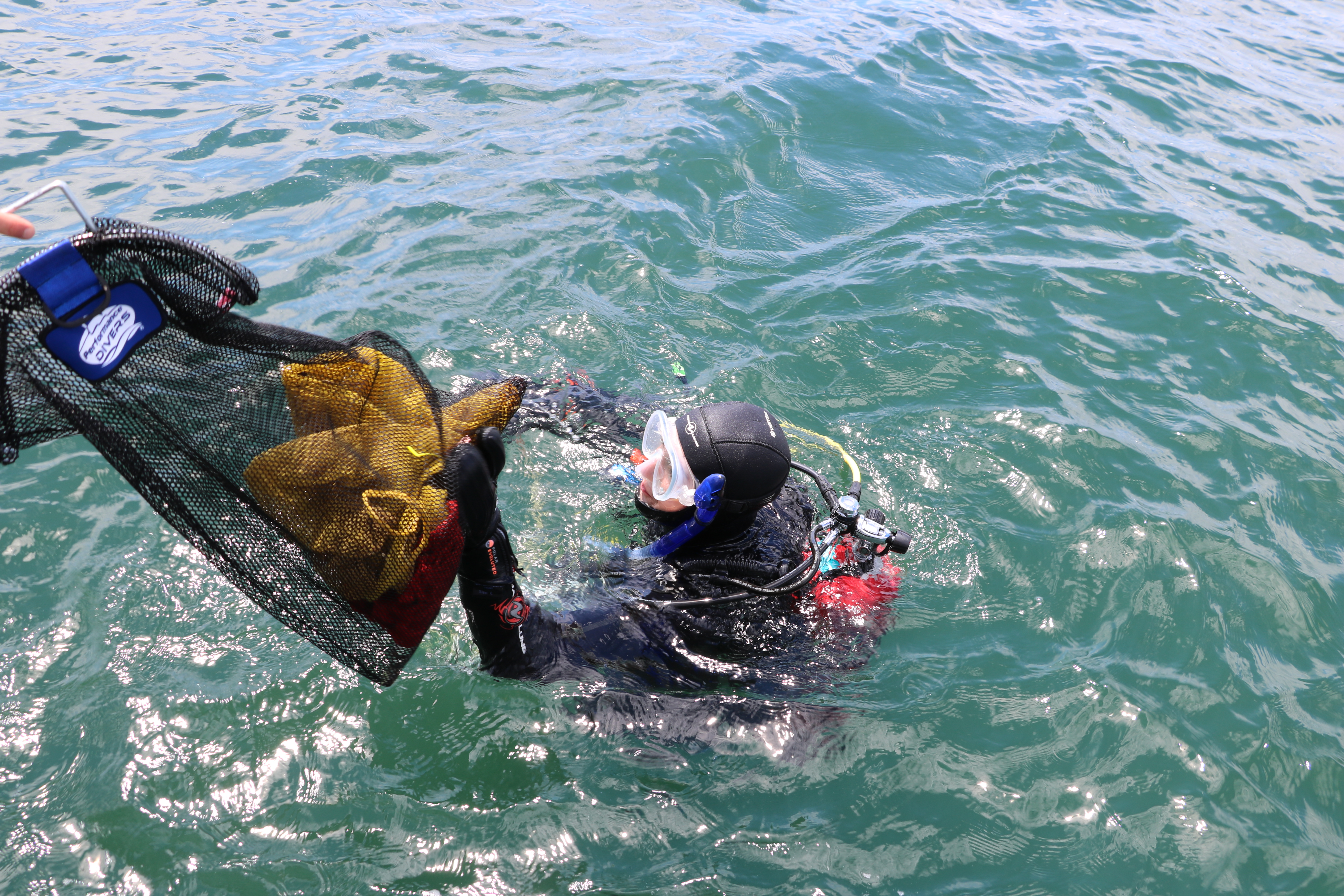
While I’m in the water, Courtney starts handing me collection bags, and quadrats from the boat.
The dives at Damariscove and Pemaquid were an entirely new experience for me. Unlike recreational dive, scientific diving has a unique feel to it. You have a mission, an objective, and you are simply using SCUBA to accomplish that goal. You aren’t diving for the pleasure of seeing kelp beds and lobster, although it’s a bonus if you like the work! On each dive, I am either diving with Doug or Thew while the other stays on the boat as surface support. Each diver is loaded with gear for the dive: writing slates with underwater paper, collection bags, transect tapes, and quadrats. A bit cumbersome on land and the surface, but underwater it is manageable. All dives start with a descent down the anchor line to the bottom. Depending on those ten-foot tides it could be anywhere from 30 to 45 feet. Once we reach the bottom, we either are directly over a kelp bed or swim a few meters to the start of one. I wait at the starting point while the other diver runs the 10-meter transect across the bottom. While the other dive is doing that, I place one of the half-meter quadrats at the two-meter mark. After laying the transect line, Doug or Thew will come to that first quadrat to begin analyzing and quantifying everything inside, including percent cover of the different kelp species. They will record the type of substrate these seaweeds are growing on and if there are any crab or lobster in the quadrats. After they are done they will move to the left side of the two-meter mark on the transect, then the right side at 4 meters, left side at 4 meters, doing this until they reach 8 meters.
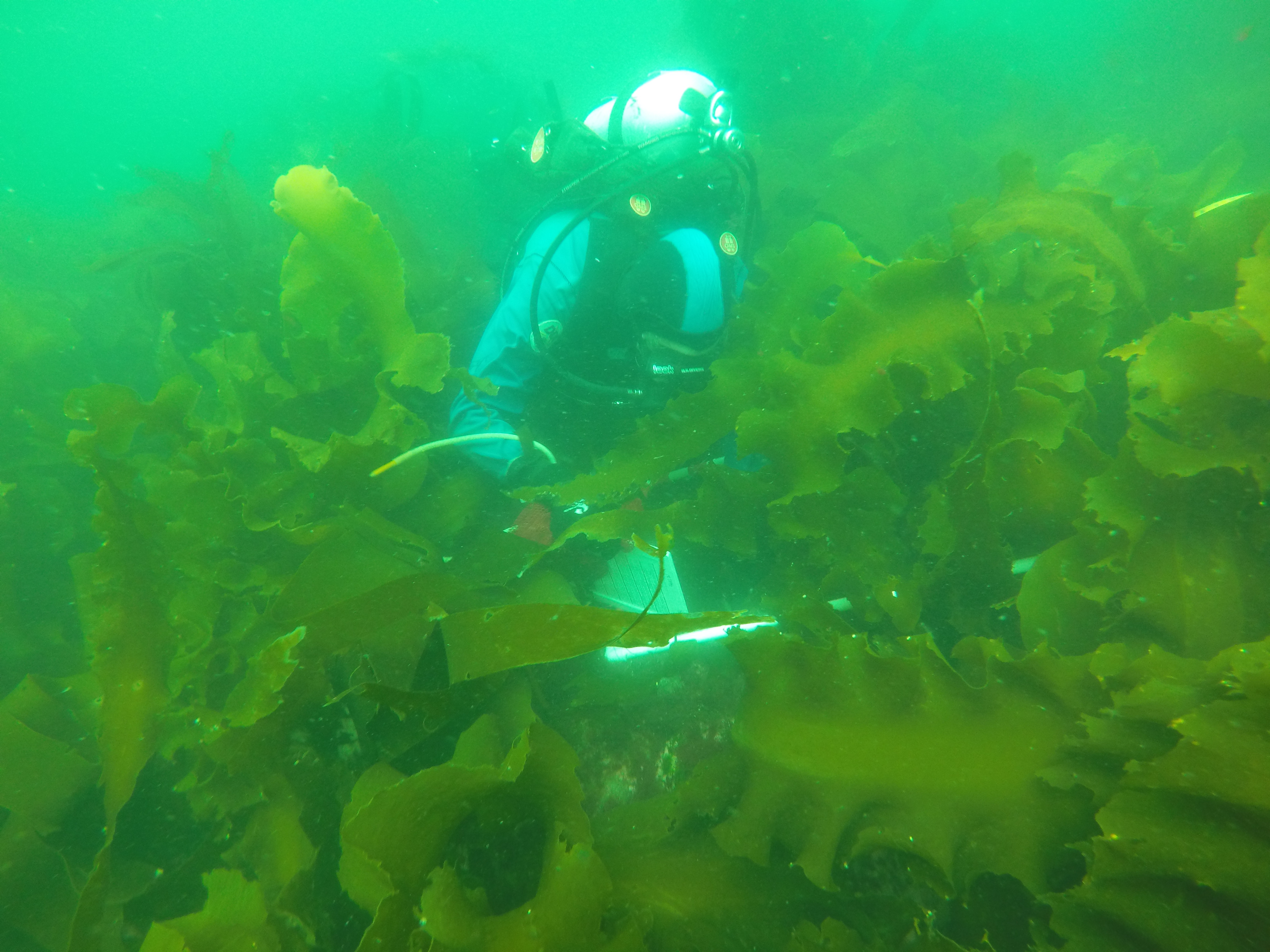
Thew trying to record percent coverage of different seaweeds in the quadrat.
After they record their data I come in and place my quadrat in the same place and begin to collect all the kelp in the quadrat. Kelp can be as big as 6-7ft or as small as an inch. Each kelp is put in a collection bag and will be later measured and weighted. Not only do I collect all the kelp I also collect all of the small understory, the small little seaweeds that cover the bottom. After both divers collect their data we pick up the transect and ascend back to the surface. We will take a short break moving to the next depth or site while getting new collection bags ready and fresh sheets of underwater paper.
The dives themselves take anywhere from 25 minutes to 1 hour. We left Bigelow at 8 a.m. and were back by 4 p.m. The water was cold, only 52F, and doing all four dives can get pretty cold. I have been graciously gifted a drysuit by USIA however, at this point it is being shipped to me, thus I’m diving a 7/8mm semi-dry which tests my fortitude. Being wet and in 50-degree water for 6 hours at a time is definitely an experience. But I love it. That’s why I came here to dive, and there was plenty happening this week.
After our one-day dive trip, we had Friday to process the samples I had collected and prep for a three-day research cruise to Hurricane Island. Hurricane Island is 10 miles southeast of Rockland and two miles southwest of Vinalhaven in the Fox Islands archipelago, Penobscot Bay, Maine. The island has a small staff along with cabins which provide hands-on education programs and research opportunities focusing on marine sciences, for all ages from middle school to adults. The island is run completely of the grid, with solar panels generating the electricity and a gravity fed pump for water. The simplicity of the island is charming.

Loading the Silver Sides for our trip to Hurricane Island.
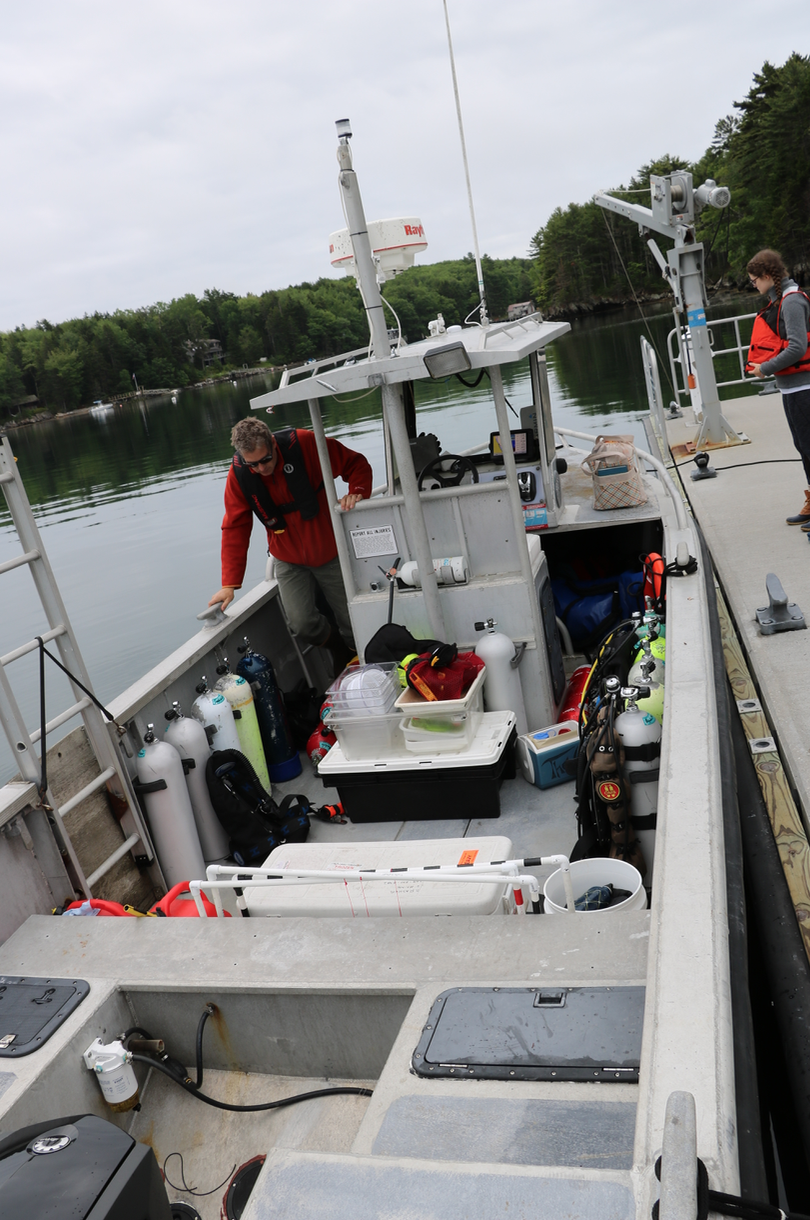
A fully load boat! 18 tanks, 3 sets of dive gear, sorting geat, and our clothing.
Our three-day trip, Sunday-Tuesday, was a work-filled fun time. Going on the trip was the usual crew: Doug, Thew, Courtney, and I. We woke up early and loaded our trusty boat, the RV Silver Sides, and started on the 1.5hr ride to Hurricane. After getting there we immediately unloaded our essential research gear and got a quick tour of the facilities. Doug has an “in” at Hurricane, Phoebe Jekielek, the Program Director for the Island. They were good friends in the early stages of their careers at the Marine Darling Center. Phoebe is this wildly funny, free spirited person with a smile that is contagious. After our dives when we would sort our samples, she would come to hang out and tell stories of when Doug and she were younger and all the “shenanigans” they got into. So after our quick tour, we jumped in the boat to go on our dives for the day. Similarly to our last dive outing, we would be sampling two sites and two depth using the sample procedure and protocols as before. It was nice to have Courtney on the boat, as an extra set of hands to help out. After a couple of long hours, we headed back to Hurricane.

Hurricane Island.

Late night sorting. Thew measures and weighs each kelp, Courtney sorts the understory, Doug trying to key out the similar looking species, and I record the species weights and length. Processing samples can take anywhere from 2-4 hours so good music and a speaker is key!
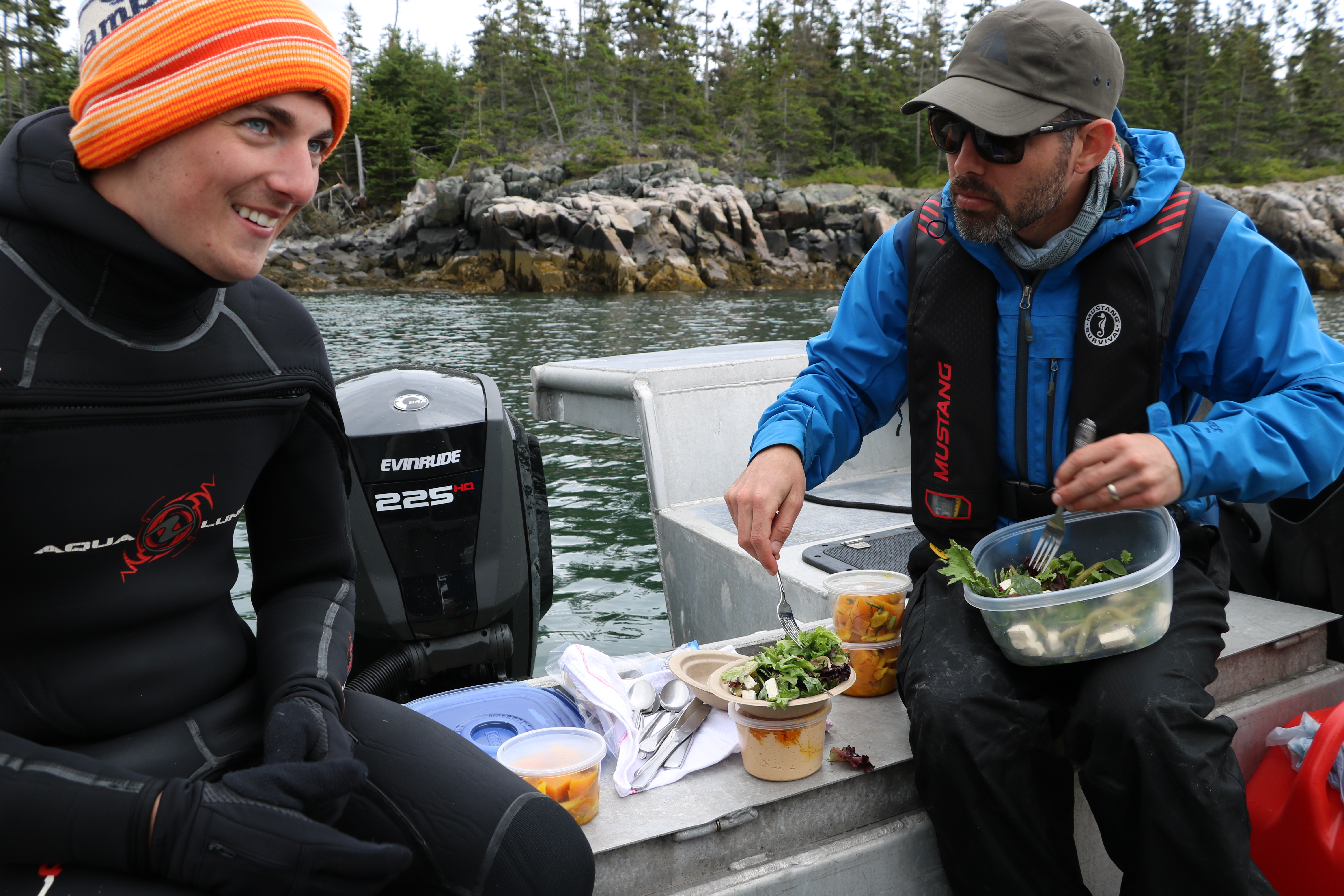
A goat cheese salad, with fresh beets along with crackers and hummus — yum.
Serendipitously, that Sunday Hurricane Island was providing a farm to table dinner, one of three they put on for the community in the summer. This white tablecloth, five-course meal, was the talk of the town and somehow Phoebe squeezed us four grubby scientists on the guest list. When we unloaded the boat we looked like a motley crew, wet, tired, dirty, and even slimy from our kelps. None of us packed nice clothes for such an occasion making this event even more comical. We cleaned up as best we could and dressed to the nines (jeans with ripped holes, and rain coats) sat for an amazing meal. Seared scallops, kale salad, halibut, pork and polenta, and rhubarb cake. Doug and Thew continuously reminded Courtney and me that this is never how nice research trips usually are and we should be extremely lucky. After the dinner was over we all slowly and painfully and to leave to process our samples, sorting, identifying, measuring and weighing kelps and seaweeds into the night. Monday was the same plan, get up, dive, and process samples. Hurricane provides it residents breakfast, lunch, and dinner, all of which are high quality and fresh meals. Although they aren’t five-course meals we still were spoiled. They even packed us an amazing lunch of salad, beets, hummus, and crackers.
In the span of our three days at Hurricane Island we dove 12 times at six different sites. Each morning was an early wake-up call, load the boat, eat breakfast and be on the water by nine. Our nights were long, getting back at six or seven followed by cleaning and rinsing gear and ourselves. Dinner would promptly follow with our day ending in sorting our samples, which took three hours with all of us working hard. It seemed like a short trip with us always being on the move or needing to complete some task. I enjoyed my time on the island and would love to go back to visit and hike their trails. For more information on Hurricane Island: http://www.hurricaneisland.net/
- The largest piece of kelp from the trip!
- One motley looking crew.
- A sea star with Doug working in the background.
- Doug waiting at our safety stop — 15ft for 3 minutes.
- Our simple but wonderful accommodations.
- Wet, Cold, and Happy.
Next week we will take a day trip to Monhegan and Allen island and I have AAUS class. During the week, we will be preparing for our down east trip which should bring lots of diving and stories. Thank you to Pheobe for being an amazing host at Hurricane and to Courtney for the GIS maps. Thank you OWUSS and AAUS.
Until next time – Shane

